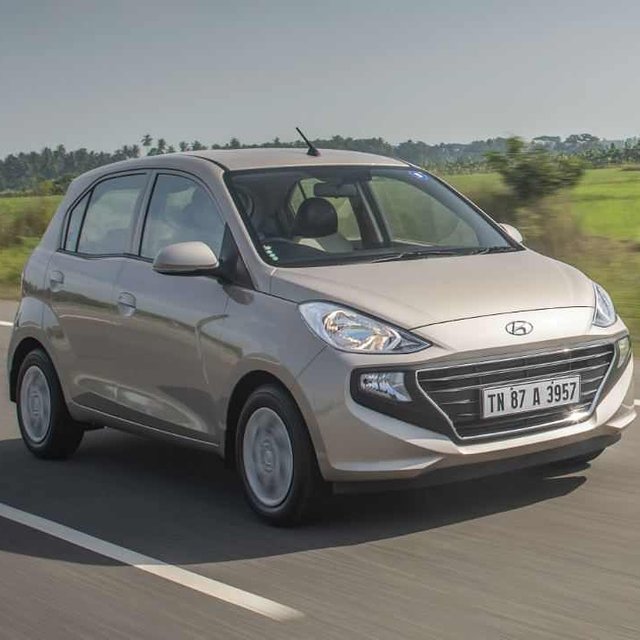
The new Santro is an all-new car and there is little to connect it to the first car Hyundai made for India. With nearly 18 lakh cars sold globally, 13 lakh of those in India, the first-gen Santro really set the path for the Korean carmaker in India which is now one of its biggest markets. While the erstwhile Santro was discontinued a few years ago, and Hyundai started its onslaught on bigger car segments, it lost its momentum a bit in the budget segment. But with the new Santro, it wants to script the entry-level success story all over again.
Surprisingly, good. The all-new K1-platform is much rigid and aids the overall ride and handling. Suspension is a straightforward set-up. McPherson struts at the front and a coupled torsion beam axle at the rear. Together it works quite well in soaking in the bumps and small potholes and at the same time keeping the car stable at high speeds. Steering provides just enough feedback at high speeds to instill confidence.
The engine has been tuned for efficiency given the nature of the target audience. The new Epsilon engine manages a modest 68bhp of peak power and 99Nm of torque. This isn’t a very heavy car but initial acceleration is muted. Things start moving only past 2200rpm and thankfully, the mid-range is meaty. What helps a lot is the slick five-speed gearbox. The manual’s throws are short and easy to slot and in case you need to show the car some stick while doing three-digits speeds it manages quite well. The AMT is quite neat in the way it manages the shift feel. Even the usual first to second shift is managed smoothly unlike other AMTs around. Almost feels like a proper automatic.
Layout, finish and space
The new car isn’t as tall as the original tall boy but is longer and wider. The wheelbase is up by around 20mm. So, there is a lot of room. In fact, there is more than adequate headroom at the rear and the cabin feels airy and spacious. At first glance, you can’t help but notice how the interior feel is very similar to the cheaper i10 but of course, this is better specced with a lot more room. There will be two interior options – dual-tone beige and all-black. The former gets champagne gold inserts around the gearbox and steering wheel, instead of the usual chrome. During the daytime, this looks pleasant although at night you may not notice the special colour.
The car feels well-built in the way the doors shut. None of the tinny feel of the earlier Santro. Some of the beige plastics lack the soft-touch feel of an upmarket car but it is all well put together with almost no rough edges. The seats are comfy and well cushioned. This, especially at the rear where the angle of the back rest and under-thigh support is one of the best we have seen in a small car. Add to that the adequate legroom and you instantly realise where two adults and a child can sit in comfort over a long journey. Speaking of which, in a first in its segment, the Santro even gets rear air-con vents. Typically, as with most Asian and Indian car makers, the air con is powerful enough to chill the interiors rather quickly, as we experienced in a rather hot and humid Bhubaneshwar during this drive.
Verdict
There are five variants on offer – D-Lite, Era, Magna, Sportz and Asta. Of these only Magna and Sports will currently be available with AMT as well. These two will also be available with the CNG option, which has a claimed 30.48kpl efficiency figure. Of course, power drops here by around 10bhp and you can kiss the 230-litre boot goodbye, as well as the cylinder, occupies it all.
The top-spec Asta gets the whole hog of features including reversing camera but is not available with automatic transmission for now. The mid-Magna variant retails for a value Rs 4.57 lakh (ex-showroom) price while Sportz is another 40k more. It gets almost all the necessary features except for rear wipers. However, it gets dual airbags as standard. ABS too is standard across all variants.
For those looking to experience some sort of nostalgia with the old car, the new Santro may not exactly offer that. But what it does is bring a strong offering of space, features and practicality to the budget family car segment. That was one of the USPs of the earlier car and that DNA strand – though not visible to the eye - has been carried over to this car. It’s a similar one-size-fits-all kind of hatchback. And that’s something that really works for buyers in this segment.
Rating
8/10
Specs
Price: Rs 3.89-5.45 lakh (ex-India)
1086cc, 4cyl, petrol, 5M/5AMT, FWD
68bhp, 99Nm, Top speed: 150kph (estimated)
FE: 20.3kpl (claimed)
LxWxH: 3610x1645x1560mm
Wheelbase: 2400mm
Tyres: 165/70 R14 steel
Hi! I am a robot. I just upvoted you! I found similar content that readers might be interested in:
http://www.topgear.com/india/reviews/car/review-2018-hyundai-santro-12435.html
Downvoting a post can decrease pending rewards and make it less visible. Common reasons:
Submit